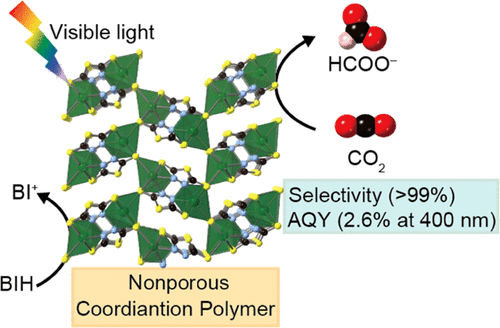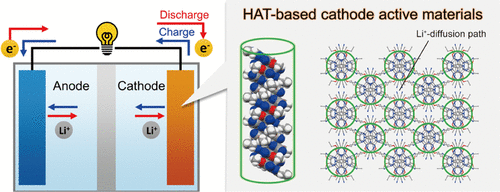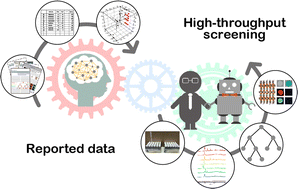Research
私たちのグループでは、錯体化学の技術を駆使して、環境エネルギー問題の解決に繋がる新しい多孔性材料の創成を目指しています。特に、構造中に周期的な細孔を有する金属-有機構造体(Metal-Organic Framework, MOF)を研究対象とし、マイクロ流路や機械学習など多彩な手法を活用して、触媒や二次電池電極材料、電子デバイス、分離材料など社会を支える機能性材料の創出に取り組んでいます。
We are the research group working on developing porous materials for the solution of energy and environmental issues based on coordination chemistry. By means of techniques such as microfluidic system and machine learning, we are trying to develop new functional metal-organic framework (MOF) utilized for catalyst, electrode materials for rechargeable battery, electronic devices, and gas separation.
カルコゲン元素を配位原子とする半導体MOFの合成 /
Synthesis of Semiconductive MOF Composed of Chalcogen Coordination Atom
MOFは、構造内部に細孔を有するため、物質の分離や貯蔵はもちろんのこと、触媒や二次電池電極材料としての応用も期待されています。しかし、従来までのMOFの多くは、架橋カルボン酸イオンの酸素を配位原子としているため、広いバンドギャップやキャリア移動特性が低い絶縁性を示します。私たちのグループでは、硫黄などの重カルコゲン元素を配位原子とすることで、可視光吸収や伝導性を組み込んだ半導体MOFの合成に挑戦するとともに、それらを用いた水分解水素発生光触媒やCO2還元光触媒、二次電池電極材料、電界効果トランジスタなど、MOF材料の新しい応用展開を目指しています。
MOFs have great potential for the use of catalyst and electrode materials as well as gas separation and storage due to their porous structure. However, the conventional MOF was composed of oxygen coordination atom originating from carboxylate group, thus resulting in a wide band gap and poor charge mobility. We synthesize chalcogen-coordinated MOF exhibiting unique electrical conductivities and optical properties and investigate its potential applications including photocatalysis for water splitting and CO2 reduction, electrode materials for rechargeable battery, field-effect transistor.

- Selective CO2-to-Formate Conversion Driven by Visible Light over a Precious-Metal-Free Nonporous Coordination Polymer
Y. Kamakura, S. Yasuda, N. Hosokawa, S. Nishioka, S. Hongo, T. Yokoi, D. Tanaka*, K. Maeda*
ACS Catal. 2022, 12, 10172-10178.
DOI:10.1021/acscatal.2c02177 - Machine-Learning-Assisted Selective Synthesis of Semiconductive Silver Thiolate Coordination Polymer with Segregated Paths for Holes and Electrons
T. Wakiya, Y. Kamakura, H. Shibahara, K. Ogasawara, A. Saeki, R. Nishikubo, A. Inokuchi, H. Yoshikawa, D. Tanaka*
Angew. Chem. Int. Ed. 2021, 60, 23217-23224.
DOI:10.1002/anie.202110629 - Redox-Active Tin Metal-Organic Framework with a Thiolate-Based Ligand
Y. Kamakura, S. Fujisawa, K. Takahashi, H. Toshima, Y. Nakatani, H. Yoshikawa, A. Saeki, K. Ogasawara, D. Tanaka*
Inorg. Chem. 2021, 60, 12691-12695.
DOI:10.1021/acs.inorgchem.1c01725 - Photoconductive Coordination Polymer with a Lead-Sulfur Two-Dimensional Coordination Sheet Structure
Y. Kamakura, C. Sakura, A. Saeki, S. Masaoka, A. Fukui, D. Kiriya, K. Ogasawara, H. Yoshikawa, D. Tanaka*
Inorg. Chem. 2021, 60, 5436-5441.
DOI:10.1021/acs.inorgchem.0c03801 - Semiconductive Nature of Lead-Based Metal-Organic Frameworks with Three-Dimensionally Extended Sulfur Secondary Building Units
Y. Kamakura, P. Chinapang, S. Masaoka, A. Saeki, K. Ogasawara, S. R. Nishitani, H. Yoshikawa, T. Katayama, N. Tamai, K. Sugimototo, D. Tanaka*
J. Am. Chem. Soc. 2020, 142, 27-32.
DOI:10.1021/jacs.9b10436
伝導性MOFおよびレドックス活性な有機化合物を基盤とした二次電池電極材料の開発 /
Synthesis of Conductive MOF and Redox-Active Organic Compounds as Electrode Materials for Rechargeable Battery
リチウムイオン電池に代表される二次電池は、現代社会を支えるエネルギー材料の1つとして広く普及している一方で、希少金属を含む電極活物質が使用されており代替材料の開発が求められています。私たちのグループでは、MOF特有の細孔を“イオン貯蔵の場”として利用することで、既存の電極材料に替わる新しい材料開発を行っています。また、レドックス活性な有機分子の配列を精密に制御することで、多孔性を有する有機化合物の合成とそれらを用いた二次電池電極材料にも取り組んでいます。
Rechargeable batteries represented by lithium-ion batteries (LIBs) are of significant interest over recent years because they exhibit high energy/power densities and a long shelf life. However, most conventional electrode active materials used in LIBs consist of rare-element-containing transition metal oxides. We are exploring MOF-based electrode active materials for rechargeable battery as alternatives to conventional electrode active materials. Furthermore, we synthesize void-containing redox active organic molecules toward the fabrication of organic electrode active materials.

- Effect of a One-Dimensional Columnar Structure on the Cathode Active Material Performance of Single-Component Hexaazatriphenylene Derivatives
R. Akiyoshi,# M. Fujiwara,# Y. Kamakura, T. Shimizu, R. Inoue, Y. Morisaki, A. Saeki, H. Yoshikawa,* D. Tanaka* (# R.A. and M.F. contributed equally to this work.)
ACS Appl. Energy Mater. 2022, 5, 12760-12767.
DOI:10.1021/acsaem.2c02377 - Application of Porous Coordination Polymer Containing Aromatic Azo Linkers as Cathode-Active Materials in Sodium-Ion Batteries
T. Shimizu, T. Mameuda, H. Toshima, R. Akiyoshi, Y. Kamakura, K. Wakamatsu, D. Tanaka*, H. Yoshikawa*
ACS Appl. Energy Mater. 2022, 5, 5191-5198.
DOI:10.1021/acsaem.2c00537 - Synthesis of Hexaazatriphenylene Charge-Transfer Complexes and Their Application in Cathode Active Materials for Lithium-Ion Batteries
K. Nakao, Y. Kamakura, M. Fujiwara, T. Shimizu, Y. Yoshida*, H. Kitagawa, H. Yoshikawa*, Y. Kitagawa, D. Tanaka*
Cryst. Growth Des. 2022, 22, 26-31.
DOI:10.1021/acs.cgd.1c00793 - Redox-Active Tin Metal-Organic Framework with a Thiolate-Based Ligand
Y. Kamakura, S. Fujisawa, K. Takahashi, H. Toshima, Y. Nakatani, H. Yoshikawa, A. Saeki, K. Ogasawara, D. Tanaka*
Inorg. Chem. 2021, 60, 12691-12695.
DOI:10.1021/acs.inorgchem.1c01725 - A New Design Strategy for Redox-Active Molecular Assemblies with Crystalline Porous Structures for Lithium-Ion Batteries
K. Nakashima,# T. Shimizu,# Y. Kamakura, A. Hinokimoto, Y. Kitagawa, H. Yoshikawa,* D. Tanaka*(# K.N. and T.S. contributed equally to this work.)
Chem. Sci. 2020, 11, 37-43.
DOI:10.1039/C9SC04175C
機械学習およびマイクロ流路、表面科学を統合したMOFの結晶化メカニズムの解明 /
Elucidation of Crystallization Mechanism of MOF Based on Machine Learning, Microfluidics, and Surface Science
MOFは、金属イオンと有機架橋配位子の無限の組み合わせのため、多種多様なフレームワーク構造を形成します。MOFは配位結合を駆動力とした自己組織化によって生成されますが、結晶化機構や細孔形成機構の詳細は明らかになっていません。私たちは、機械学習やマイクロ流路、薄膜合成など表面科学的な手法を組み合わせることで、MOFの結晶化メカニズムの解明や新しい合成手法の開拓を目指しています。
In general, MOFs form a wide variety of pore-containing framework through coordination-driven self-assembly. However, the details of the crystallization and pore formation mechanisms have not been elucidated. Our research goal is to reveal the crystallization mechanism of MOFs by machine learning, microfluidics, and surface science-based approach, consequently developing new synthetic approach for MOFs.

- Data-Driven Efficient Synthetic Exploration of Anionic Lanthanide-Based Metal-Organic Frameworks
Y. Kitamura, Y. Nakamura, K. Sugimoto, H. Yoshikawa D. Tanaka *
Chem. Commun. 2022, 58, 11426-11429.
DOI:10.1039/D2CC04985F - Synthesis of Mixed-Metal MIL-68 under Mild Conditions by Controlling Nucleation Using a Microfluidic System
S. Yamada, A. Hirano, Y. Tanaka, R. Akiyoshi, H. Yoshikawa, D. Tanaka*
Cryst. Growth Des. 2022, 22, 4139-4145.
DOI:10.1021/acs.cgd.2c00140 - Redox-Active Tin Metal-Organic Framework with a Thiolate-Based Ligand
Y. Kamakura, S. Fujisawa, K. Takahashi, H. Toshima, Y. Nakatani, H. Yoshikawa, A. Saeki, K. Ogasawara, D. Tanaka*
Inorg. Chem. 2021, 60, 12691-12695.
DOI:10.1021/acs.inorgchem.1c01725 - Competing Roles of Two Kinds of Ligand during Nonclassical Crystallization of Pillared-Layer Metal-Organic Frameworks Elucidated Using Microfluidic Systems
Y. Tanaka, Y. Kitamura, R. Kawano*, K. Shoji, M. Hiratani, T. Honma, H. Takaya, H. Yoshikawa, T. Tsuruoka, D. Tanaka*
Chem. Eur. J. 2020, 26, 8889-8896.
DOI:10.1002/chem.202001438
